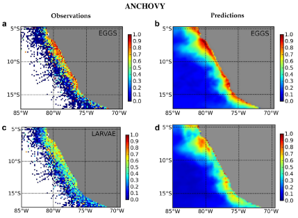
Peru Ecosystem Projection Scenarios (PEPS)
Though it represents less than 1% of the ocean surface, the Peru/Chile upwelling system, also known as the Humboldt Current System (HCS) accounts for up to 20% of the global fishing catches.
This resource is highly variable at various time scales and the societal and economical impacts of fish catches fluctuations are major. The goal of this project is to study and assess the impact of Climate Change on the Peruvian sardine and anchovy fisheries. The first step is to study the past variability and validate the realism of the downscaled environmental parametersduring the last decades (1958-present) using a comprehensive regional data set and a hierarchy of dynamical, biogeochemical and biological models.
Challenges of this project include high resolution physical and biogeochemical modeling of coastal upwelling system and adaptation of the model SEAPODYM initially developed for large pelagic fish species (eg tunas) to small pelagic species.

Annual mean distributions of observed (left) and predicted (right) eggs and larvae density (from Hernandez et al (2014).
REFERENCES
Hernandez O., Lehodey P., Senina I., Echevin V., Ayon P., Bertrand A., Gaspar P., (2014). Understanding mechanisms that control fish spawning and larval recruitment: Parameter optimization of an Eulerian model (SEAPODYM-SP) with Peruvian anchovy and sardine eggs and larvae data. Progress in Oceanography 123, 105-122. http://dx.doi.org/10.1016/j.pocean.2014.03.001
